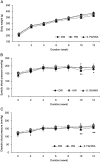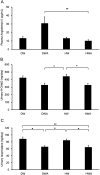Effects of hydrogen-rich water and ascorbic acid treatment on spontaneously hypertensive rats
- PMID: 35264492
- PMCID: PMC9388348
- DOI: 10.1538/expanim.21-0187
Effects of hydrogen-rich water and ascorbic acid treatment on spontaneously hypertensive rats
Abstract
Hydrogen-rich water (HW) has been suggested to possess antioxidant properties of value in treatments of lifestyle diseases and for prevention of latent pathologies. To date, the potential benefits of HW against the deleterious effects of excessive salt intake and hypertension have not been investigated. Here, we first examined the effects of HW or HW supplemented with 0.1% ascorbic acid (HWA) on spontaneously hypertensive rats (SHR) that had been fed a normal diet. In comparison to control rats given distilled water (DW), we found that HW did not significantly influence systolic blood pressure (SBP) or diastolic blood pressure (DBP) in SHR; however, the increase in SBP and DBP were inhibited in the HWA group. Next, four groups of SHR were given DW, 0.1% ascorbic acid-added DW (DWA), HW, or HWA in combination with a 4% NaCl-added diet. SHR fed the 4% NaCl-added diet showed increased hypertension; HWA treatment resulted in a significant reduction in blood pressure. The HWA group tended to have lower plasma angiotensin II levels than the DW group. In addition, urinary volumes and urinary sodium levels were significantly lower in the HWA group than the DW group. Urinary isoprostane, an oxidative stress marker, was also significantly lower in the HWA group, suggesting that the inhibitory effect of HWA on blood pressure elevation was caused by a reduction in oxidative stress. These findings suggest a synergistic interaction between HW and ascorbic acid, and also suggest that HWA ingestion has potential for prevention of hypertension.
Keywords: ascorbic acid; hydrogen water; hypertension; oxidative stress; spontaneously hypertensive rats (SHR).
Conflict of interest statement
This study was funded to KK by Tech Corporation. DS, and MN are employees of Tech Corporation. HM, TY, and KM have no conflicts of interest.
Figures





References
-
- Fitzgerald C, Aluko RE, Hossain M, Rai DK, Hayes M. Potential of a renin inhibitory peptide from the red seaweed Palmaria palmata as a functional food ingredient following confirmation and characterization of a hypotensive effect in spontaneously hypertensive rats. J Agric Food Chem. 2014; 62: 8352–8356. doi: 10.1021/jf500983n - DOI - PubMed
-
- Li GH, Qu MR, Wan JZ, You JM. Antihypertensive effect of rice protein hydrolysate with in vitro angiotensin I-converting enzyme inhibitory activity in spontaneously hypertensive rats. Asia Pac J Clin Nutr. 2007; 16:(Suppl 1): 275–280. - PubMed
MeSH terms
Substances
LinkOut - more resources
Full Text Sources
Other Literature Sources
Medical

